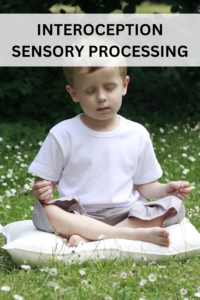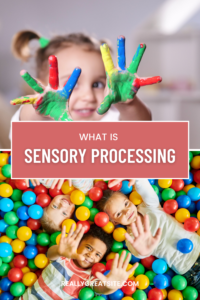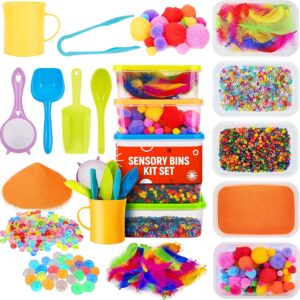
Have you heard of interoception sensory processing? Maybe this is a new sense to you, and you would like to learn more about it. Perhaps you are a new occupational therapist or a parent whose child is in occupational therapy, and their OT has mentioned it to you when discussing their sensory processing skills.
No matter what brought you here, this post dives into the term interoception sensory processing and provides 5 activities that will help your child strengthen this skill, improving their overall well-being.
This post was created by Marra Robert, OTD, OTRL and contains affiliate links.

Do you ever stop to think about how your body feels on the inside? Most of us don’t give much thought to the sensations we experience within ourselves, but what if I told you that understanding and harnessing this hidden power within could profoundly impact children’s overall well-being?
Hi! My name is Marra, and I’m a mama and a pediatric occupational therapist with years of experience working with children with autism and helping their parents navigate the ups and downs of child development.
I loved supporting parents learning about autism, sensory processing, and their child’s individual needs. I love providing them with resources, strategies, and activities to help them help their child. I hope to do the same for you.
This article delves into the fascinating world of interoception sensory processing, exploring what it is and how it affects children. We’ll also provide five practical activities to help kids improve their interoception sensory processing skills.
So, let’s unlock the hidden power of interoception and discover how it can make a world of difference in children’s lives.
What is Sensory Processing?
Before we start talking about interoception sensory processing, we first need to take a closer look at sensory processing as a whole and how it affects everything we do.
Sensory processing is our ability to take in information through our 8 senses, make sense of all of it, decide what we need to pay attention to and what we can ignore, and then choose a response.
Yes, we do have 8 sensory systems. We have the more well-known 5 sensory systems, including what we see, hear, taste, smell, and touch. We have 3 lesser known sensory systems: proprioception, vestibular, and interoception, which we will discuss in this post.
Our proprioception is our sense of deep pressure and body awareness. Our vestibular sensory system is our sense of balance and response to gravity. We will discuss interoception in more detail in the sections below.
If you want to learn more about sensory processing and our 8 sensory systems, check out the post below.

What is Interoception Sensory Processing?
Interoception sensory processing is a concept that may seem unfamiliar to many of us. It is one of the newest senses to be recognized and plays a vital role in our overall well-being, emotional state, and participation in everyday activities.
It involves the awareness and understanding of the internal sensations within our bodies. Just as we perceive the world through our other senses, interoception allows us to perceive and interpret signals from within ourselves.
These senses can include hunger, thirst, pain, temperature, heartbeat, stomach ache, and even emotions. These senses are sent up to the brain, and the brain processes them and integrates them with all of the other information received from the other sensory systems.
Interoception sensory processing is crucial to our overall well-being and is particularly important for children’s development. It helps them recognize and regulate their bodily needs, emotions, and responses.
Children with strong interoceptive senses are better equipped to navigate their daily lives, make healthy choices, and form meaningful connections with others.
Simply put, interoception sensory processing is like having an internal GPS that guides children in understanding and responding to their bodies.
It allows them to listen to the subtle cues their bodies send them, enabling them to make informed decisions about things like when to eat when to rest, when to seek help, and when to communicate their feelings.
Children can tap into this hidden power by developing interoceptive skills and gaining a deeper understanding of themselves. This improves their self-awareness and enhances their ability to regulate their emotions and navigate social interactions with greater ease. Ultimately, it empowers them to take control of their physical and emotional well-being.

THE IMPACT OF INTEROCEPTION SENSORY PROCESSING
It’s important to know that just like being sensitive to some sensory input or having difficulty processing certain sensory information, some children can have trouble with interoception sensory processing.
This means that, for whatever reason, their brain is having a more challenging time understanding the signals being sent from the body. This can impact activities such as using the toilet, eating, temperature control, and pain sensation.
Imagine not having a clear idea of when you are hungry or full or have to use the restroom. This would be really challenging and frustrating. On top of that, some children might not have the words to communicate their needs or are confused with how they are feeling either because of their age or developmental skill level.
You can see why it can be really challenging for a child to move through their day when they have difficulty with interoception sensory processing. For that reason, it can lead to emotional dysregulation.
They may, what we think over react to a particular situation or become upset quickly, and it is challenging to know why. It could have nothing to do with their outside environment and how they feel inside.
It’s important to remember this when working with children who have difficulty with interoception sensory processing. The first step is to create a safe space for the child and to develop a positive, trusting relationship with them, whether you are working with them in a therapeutic setting or caring for them.
Children can tap into this hidden power by developing interoceptive skills and gaining a deeper understanding of themselves. This improves their self-awareness and enhances their ability to regulate their emotions and navigate social interactions with greater ease.
Ultimately, it empowers them to take control of their physical and emotional well-being. I’ve listed 5 activities below that can help improve their interoception sensory processing.

5 ACTIVITIES TO IMPROVE INTEROCEPTION SENSORY PROCESSING.
1. IdENTIFY AND TALK ABOUT HOW YOU ARE FEELING
One of the best ways we can empower children to understand and improve processing of how their bodies are feeling is to give them a vocabulary or alternative way to communicate their feelings.
This can be through simple words, signs, pictures, or even a simple thumbs up or thumbs down, which can really help. Start with however best your child is communicating now and then slowly increase their words by adding to it with emotion words and ways to describe how their bodies are feeling,
As mentioned above, creating a safe space and a trusting relationship with your child is important. Continue to let them know that their voice matters and that their feelings are validated.
This does not mean that they always get whatever they want. It simply means that you hear them and understand what they are trying to say. We all want to be understood in our relationships; children are no different.
Another way you can help teach children to express their emotions is by modeling them and sharing more of your emotions with them. It’s Okay; in fact, it can be really valuable to express emotions such as sadness, frustration, and excitement to our children.
We can follow up by sharing healthy calming strategies we use to help manage our emotions. I think talking about how we feel and our bodies and feelings are very powerful for children.

2. Mindfullness activities
Mindfulness exercises are another activity that can help enhance interoception sensory processing skills. These exercises encourage your child to focus on their body sensations and internal signals. Practicing mindfulness regularly can help them develop a heightened awareness of their emotions, physical sensations, and needs.
3. Sensory Exploration
Another effective activity is sensory exploration. This involves providing your child with various sensory experiences, such as touching different textures, smelling different scents, and tasting different flavors.
By exposing them to a wide range of sensory stimuli, you can help them become more familiar with their own body’s responses and sensations. As mentioned above, adding language to express their likes and dislikes is important, and this is a great way to do so.

4. Yoga
Yoga and breathing exercises are some of my favorite activities with kids and can also be beneficial for interoception sensory processing. These activities promote body awareness and teach your child how to regulate their breathing, calming their nervous system and helping them better tune in to their body’s signals.

5. Creative Arts
Engaging in creative activities, such as art therapy or journaling, can also help enhance interoception sensory processing skills. These activities encourage self-expression and reflection, allowing your child to explore their emotions and thoughts more deeply.
By incorporating these activities into your child’s daily routine, you can further integrate interoceptive strategies into their lives. These activities will not only support their sensory processing abilities but also foster a greater sense of self-awareness, emotional regulation, and overall well-being.
By nurturing their interoceptive skills through these activities, you give your child the tools to navigate the world with increased self-awareness and understanding. They will be better equipped to recognize and respond to their needs, leading to a brighter future filled with improved emotional well-being and greater empowerment.

